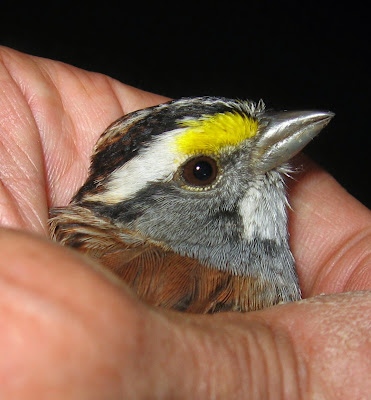Often heard early in the spring – even a small chorus of these tiny frogs can be deafening – but seldom seen, Western Chorus Frogs (Pseudacris triseriata) can survive being frozen and are out and about seeking potential mates when there is still snow and ice on the marshes and temporary vernal pools that are their breeding sites.
In addition to its song (reminiscent to running your fingernail along the teeth of a comb), the dark stripe through the eye, white upper lip and long spots or blotches distinguish this species from the Spring Peeper.
Calling for a girl friend ... the frog's vocal sac distends to twice the size seen in this photo.
It looks like this male sang loud enough and long enough to capture the attention of a female, and judging by their numbers these pairings no doubt happen many a time.
There's only one way to capture a close-up image of a 3 cm long frog with a point-and-shoot camera. My pants are wet up to the knees and my shoes still aren't completely dry two days later ...
Also seldom seen (and hopefully never heard, if so, see a psychiatrist) – Sarcoscypha coccinea, better known by the fanciful name Scarlet Elf Cup. This eye-catching early spring Ascomycete is not uncommon but it's often overlooked because it's buried under leaf litter.
Never heard, generally not considered to be eye-catching and frequently overlooked, and wish it was much less often encountered – the Black-legged Tick a.k.a. Deer Tick (Ixodes scapularis). I think I picked up this unwelcome hitchhiker when I bumped my head against a shrub during the incursion into the marsh – on my own head be it, so to speak.
I was onto the little sucker out not long after she started biting me, and while I'm not certain I got the hypostome out, it alone won't transmit Lyme Disease and the tick needs to be attached for several hours in any event. So it seems I'm off the hook, but just to play it safe I'm going to monitor the bite site for the next couple of weeks ...
There's a good reason a tick's hypostome is difficult to remove once it's firmly inserted. Have a look at the macro of the "business end", as it's so nicely put, of Dermacentor albipictus at
Macromite's Blog.
Distant cousins of the Deer Tick – and a lot less bloodthirsty, at least from a mammalian perspective – Habronattus spp. are among the first jumping spiders apt to be encountered in spring. The next two images depict a Habronattus calcaratus maddisoni female and male. The spiders were found only a few centimeters from one another, no doubt there was a mating in the offing.
The male Habronattus viridipes closely resembles its cousin, but note the sinuous white line on the cephalothorax and the irregular borders of the black stripes on the abdomen. The first pair of legs of both species have a bright green inner surface, used by the males to signal to a prospective mate.
As always many thanks to the experts at
BugGuide.Net for their help. I was fairly certain as to the genus these small Salticids (5 cm, give or take) but I couldn't have identified them to the species (let alone subspecies) level without some guidance. Another great website for identifying Salticidae is
Jumping Spiders of North America.
Both of the Habronattus spp. were encountered on open rock outcrops in high and dry pine/oak/blueberry scrub habitat – the home of the
Common Five-lined Skink. The little reptiles are still with us, first sighting for 2014 was Sunday April 27th, and a friend managed to get a photo before it scurried for cover.
The stony blueberry scrub is also a good place to look for the Bumble Flower Beetle (Euphoria inda). About the size of a June Beetle, this hairy scarab not only mimics the appearance of a bumblebee, it even drones like one while in flight. The larvae live in dung and decomposing wood, and there's lots of the latter laying around; they mature and fly in late summer and the beetles seen in the spring have overwintered as adults.
It's been a long cold winter and a late cool spring, I wonder if the
"immigrant" species from warmer climes that have been extending their ranges northward made it through?















